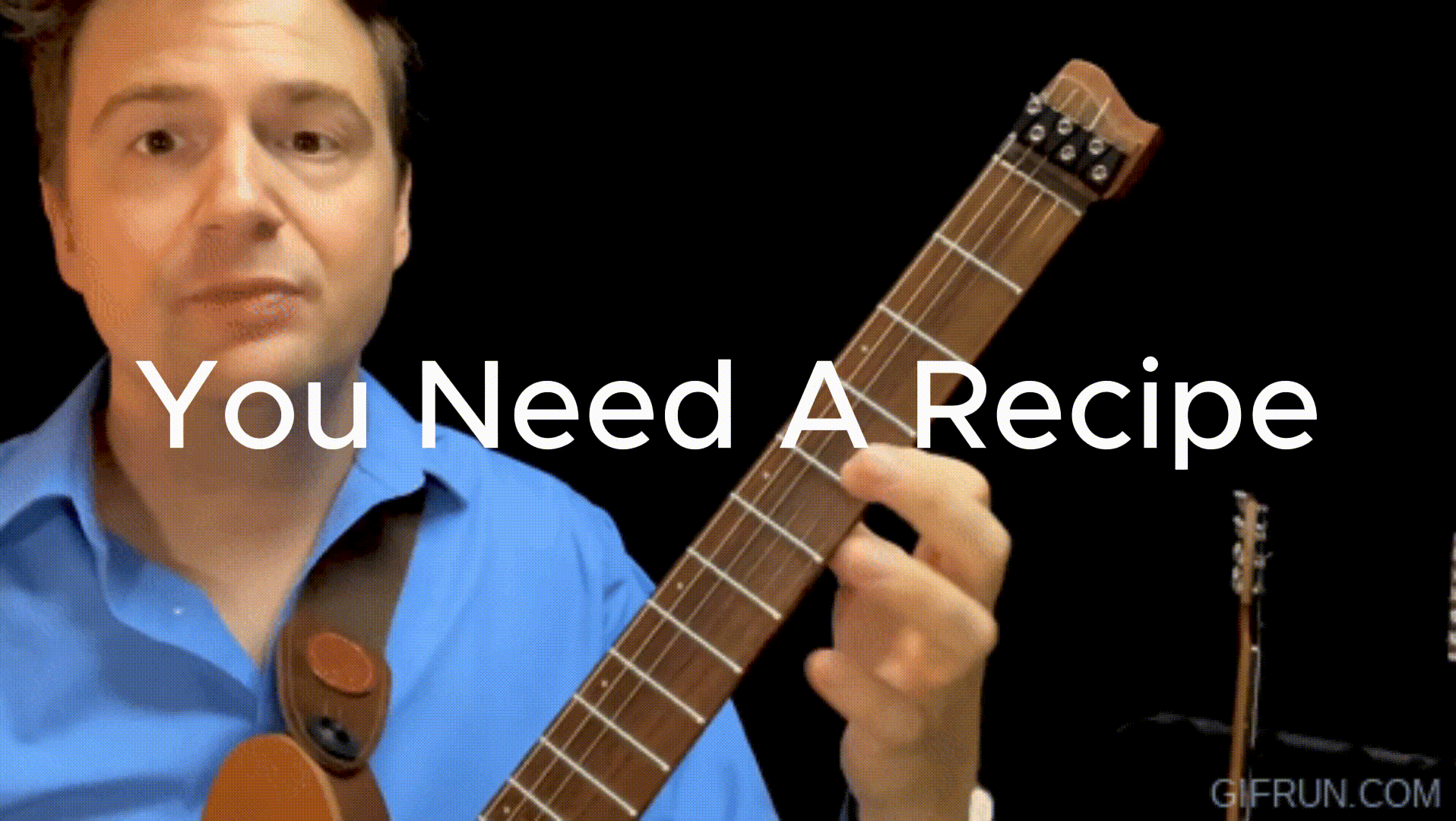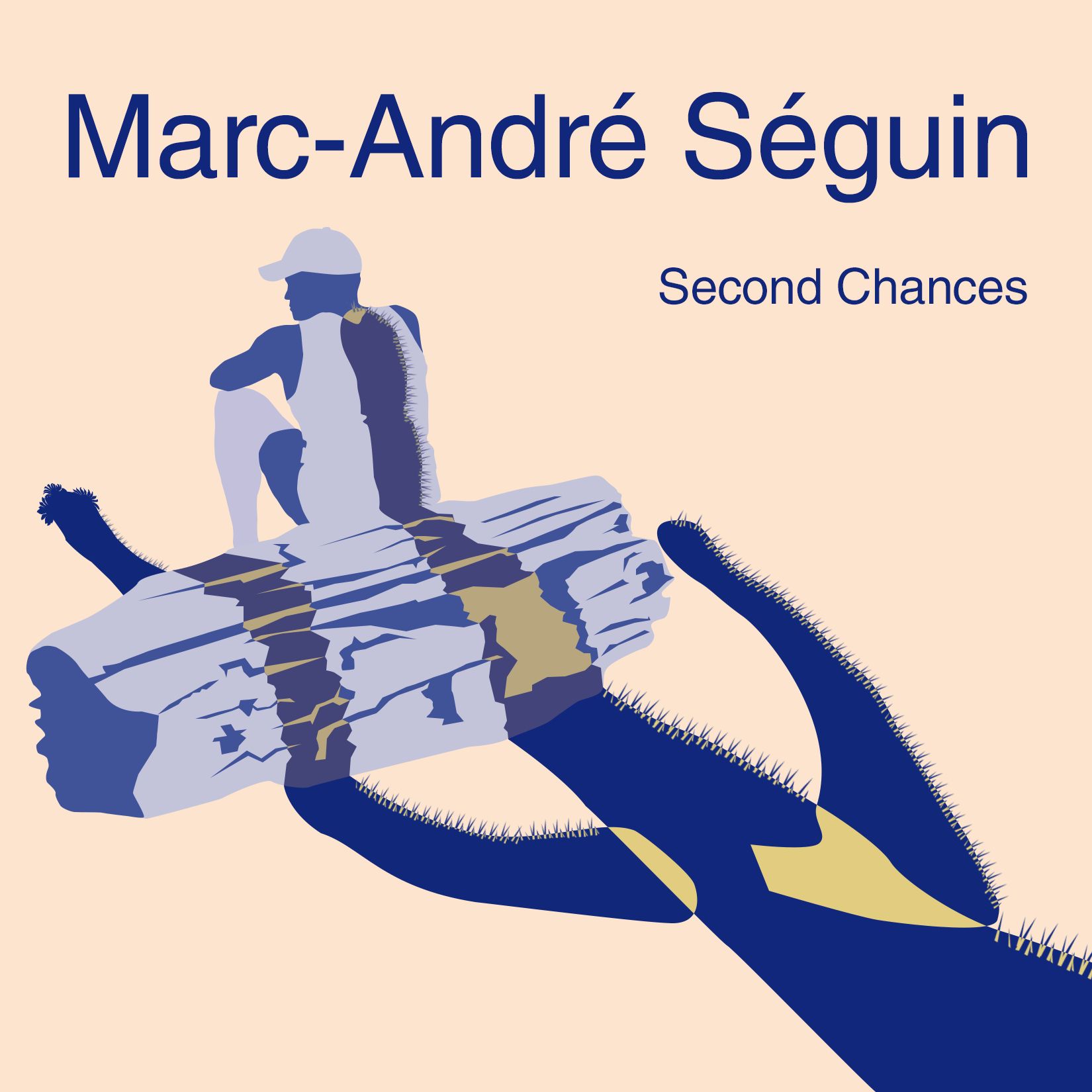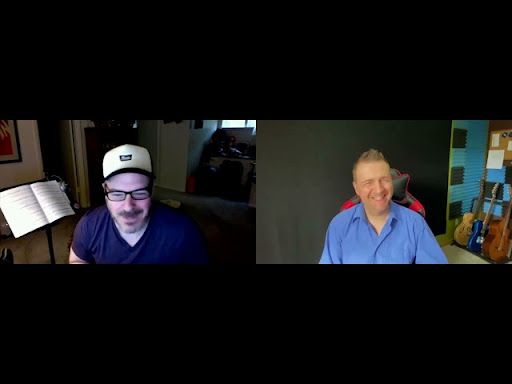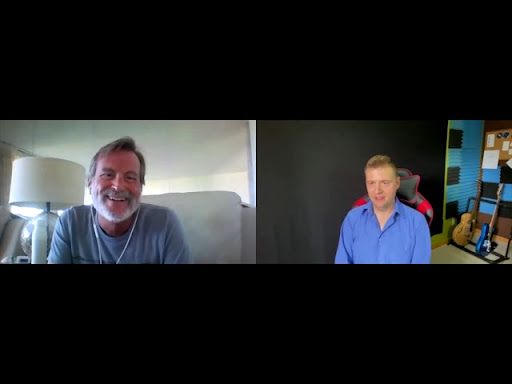For Guitarists & Lifelong Lovers Of Music Looking To Finally Crack The “Jazz” Code:
How To Make Jazz Guitar Feel Like Second Nature

An Extensive NO-NONSENSE Guide To Improvising And Comping On The Guitar
…without losing your sanity in the process
Preface
There’s a common teaching myth that you must learn “all scales, all arpeggios, in all positions, in all keys” before you can truly play jazz. But is that massive list of prerequisites *really* essential to become a confident jazz guitarist?
(Hint: not so much.)
Think of baking a cake: you need a recipe, not just random ingredients. In jazz guitar, that recipe is a clear, repeatable system—not just scales or chord theory. By following a practical process, you can move forward faster, stay motivated, and have real fun playing jazz.
Let me show you the exact “recipe” I use with my best students.


Author: Marc-Andre Seguin
References
Before we dive in, here’s proof that this process actually works. Below is a snapshot of my students’ self-reported progress in 2022:
The average student sees 4x improvement in just 90 days. [Click Here]

And here are a few short samples of me playing (originals):



The Frank Waltz: (I'm on the left with the blue guitar)
Here’s a clip of one of my students, Miles Barel, about 8 months into the process:
Check out even more student testimonials here:
And finally, you can browse hundreds of student testimonials:
https://www.jazzguitarlessons.net/reviews
Intro
In this presentation, you’ll discover a step-by-step roadmap to making jazz guitar feel natural—where improvising and comping become second nature. If you follow this system exactly, you’ll see real progress:
• You’ll have the confidence to shine at jam sessions.
• You won’t sweat it when someone asks, “Hey, play me a tune!”
• You’ll always know what to focus on in the practice room.
• You’ll actually have fun doing it.
But there’s one big request I have: do not treat this as just another “guide.”
Use it. Better yet, abuse it. This took me weeks to assemble and years to refine. Give it your honest 20 minutes (bookmark it if you can’t finish now). If you want a PDF copy, contact me at the end of this page.
My mission is to change how jazz guitar is taught, removing confusion and wasted effort. Read it once to see the big picture, then come back daily to implement each step. Let’s go!
Who is this for?
This is for you if:
• You’re a guitarist who deeply loves music but still struggles to get through an entire jazz tune from A to Z (with melody, chords, and even a little improvisation).
• You might feel stuck between “not a beginner anymore” and “not quite intermediate.”
• You understand some chords, scales, or licks in theory but can’t improvise or accompany confidently.
• You’ve tried to shortcut your way into jazz using what worked for rock or blues—spoiler: it doesn’t.
• You’ve spent time on YouTube or purchased random transcriptions, but still feel you’re missing a real process.
If you haven’t found a clear, step-by-step plan that respects your time and leads you to solid jazz playing, you’re in the right place.
The Problem:
Let’s be real: learning jazz is hard. It’s known as the “chess” of music. There’s complex harmony, deeper vocabulary, and improvisation that demands skill and awareness. Even top-level pros admit it takes years of dedication.
Worse still, the “masters” of jazz often struggle to explain what they do in actionable steps. Combine that with the massive amounts of random videos, books, and courses—and it’s easy to see why most players feel overwhelmed or stuck.
You might wonder if you’re just “not cut out” for jazz. But the real problem usually isn’t your talent; it’s that the information alone doesn’t transform your playing. You need a structured system, solid practice habits, and consistent feedback—without those, you’re left spinning your wheels.
The Truth:
Despite the complexity, jazz guitar doesn’t have to be harder than rock, blues, or pop. It just requires a different (and smarter) approach. If you focus on repertoire, small daily habits, and essential feedback loops, your progress skyrockets.
In other words, Implementation Beats Information.
The best news: if you’ve already spent time on chords, scales, and techniques, you have the “ingredients.” What you’re missing is the recipe to tie it all together. That’s exactly what I’ll share now.
The Jazz Standards Pathway Process
Below is a bird’s-eye view of the “divide and conquer” system I teach my private coaching students. It works by focusing on one song at a time, tackling clear steps in a logical order. Here’s the overview:
0. Pick a Tune
1. Staple Chords
2. Conveyor Belt
3. Skinny Chord Melody
4. Bullseye Method
5. 4.C.E
6. Shell + Movement System (SMS)
7. Tune-Centric Improvisation Method (TCIM)
8. Rinse & Repeat (Infinite Skills)
Each step is 100% actionable, cuts out the nonsense, and ensures you’re playing music, not just “collecting” chords and licks in a vacuum.
About Me
I’m Marc-Andre Seguin, founder of JazzGuitarLessons.net. I started as a kid on piano, then guitar at 12, dabbling in rock, metal, and blues. Eventually, I went to university for classical and jazz studies, fell in love with the language of jazz, and spent years gigging, busking, and teaching.
I’ve been broke, I’ve been a barista, I’ve taught thousands of private lessons—and I kept refining a better way to learn jazz guitar. Eventually, in 2009, I created JazzGuitarLessons.net, and it’s now helping guitarists worldwide master jazz standards with confidence. My goal is to transform jazz education so players can finally see consistent progress and joy in their music.

Your Step-By-Step Process

Step 0: Pick a Tune or Progression
Rather than memorize every scale & chord, or work on technique in isolation, start with a single tune. That’s your lab for everything you learn. Pick something classic and accessible—like “Autumn Leaves,” a blues, or “All the Things You Are.” Commit to it, and you’ll have a reference point for all the steps below.
Step 1: Staple Chords
Focus first on getting one simple chord voicing for each chord on your lead sheet. Group chords into four families (Major, Minor, Dominant, Other) and pick a single “Staple” shape for each.
The Staples are commonplace guitar chords with root on the 5th or 6th string.
These shapes give you an immediate, great-sounding, easy-to-remember chord. Forget about every inversion or extension—just pick one for each chord and memorize it in context. If you catch yourself feeling “this is too basic,” record yourself to make sure you’re actually nailing it.
Remember: Implementation Beats Information. Don’t hoard chord shapes you can’t use in a song.
Step 2: Conveyor Belt
Now we add tempo and time. The idea is that most jazz tunes flow in a steady pulse, or “conveyor belt,” over a certain number of measures. Practice your newly learned Staple Voicings in time, using a basic rhythmic pattern (like four-to-the-floor or the Charleston).
Count out loud, be aware of chord transitions, and keep that pulse rolling. This step might feel tricky because you’ll see exactly where your timing or chord transitions falter. That’s good—no more illusions. Record yourself, fix the issues, and move on.
Step 3: Skinny Chord Melody (CM)
In this step, you’ll create a simple, complete arrangement—melody plus chords in time. Think of it like a basic piano-style approach: top voice for the melody, a few well-chosen chords underneath. Don’t overcomplicate with dense chord stacks. Keep it “thin” so the melody stands out.
If someone walked in while you’re playing, they should recognize the tune. That’s the key. Chord melody is where you actually learn the song—not just an exercise. Practice slowly, keep the groove, and let the melody sing out clearly.
Step 4: Bullseye Method
Now we tackle single-note lines and basic improvisation by focusing on key target notes (like the 3rd of each chord). Before a chord even arrives, you’re setting up that crucial tension and resolution.
This is the “secret sauce” of jazz improv: hearing where the chord is going and preparing for it.
In jazz lingo, we say "making the changes".
Don’t force yourself to memorize every scale or arpeggio in every key. That can come later. For now, keep it straightforward: pick a target note (often the 3rd), approach it with a few notes, and land in time.
Step 5: 4.C.E
Time to combine everything. You’ll cycle through three roles with your tune. This is a jam session, or as I like to call it, the "synthesis step".
- 5A: Naked Melody (top strings only, no chords)
- 5B: Comping (Staple Voicings in a repeating jazz rhythm)
- 5C: Simple Improvised Solo (inspired from Step 4)
- 5D: The melody again (a.k.a. "head out"
No stopping, no rewinding. You’re simulating a real jam session—just you, a backing track (or looper), and the “Conveyor Belt” form. This is where you learn to play from start to finish without bailing out, discovering how to manage time, transitions, and mistakes.
Remember: fewer fancy shapes, more consistent groove.
Step 6: Shell + Movement System (SMS)
Ready for more color? Remove the bass notes from those Staple Voicings and you get “Shells.” Suddenly, the chord is lighter, more flexible, and you can move top notes for extra melodic interest. Think of it like painting different hues on the same chord.
Keep applying the same Conveyor Belt rules, but now with Shells+1 or Shells+2 (three or four-note chords). This typical is found on string D-G-B or D-G-B-E on the guitar.
This might call for partial barres or new finger stretches. Go slow, stay relaxed, and keep time first and foremost.
Step 7: Tune-Centric Improvisation Method (TCIM)
Finally, we polish your improvisation with four short drills on the tune’s form:
1. Guide-tones (focus on the 3rd, 7th, etc.)
2. Scales (1→7 pattern, used in context of the tune)
3. Arpeggios (1-3-5-7)
4. Resolutions (make each chord lead to the next)
After the drills, improvise freely and notice what improved. Avoid practicing these “in isolation” forever—context is key.
By the end of Step 7, you’ll know exactly which areas need more attention in your next practice session.
“Step 8” - RINSE and REPEAT for infinite skills
Pick a new tune, go back to Step 1. Revisit old tunes to polish them more deeply. Each round you repeat strengthens your repertoire, your fingerboard knowledge, and your confidence.
It’s an endless growth loop. Notice that the number 8 is actually a vertical infinity sign. Good coincidence.
No matter how advanced you get, you can always refine each step. Voila, you're implementing the Jazz Standards Pathway while developing your repertoire and vocabulary.
Congratulations! 🎉
Remember our motto:
Implementation Beats Information—so don’t pile on new stuff until you actually apply what you’ve learned.
Next Steps
You have three options:
1. Do Nothing
Stay in your current routine, keep piling up more theory or transcriptions without structure. Keep watching the new YouTube videos as they come out, keep buying books or online courses.
You’ll probably still feel anxious when someone says, “Play me a tune,” or you sit down at a jam session. I don’t recommend this.
2. Try the System on Your Own
You can absolutely follow the stages in the Jazz Standards Pathway yourself.
If you’re disciplined and can hold yourself accountable, you’ll see success—but it could take longer, and you’ll still miss out on expert feedback. It’s easy to procrastinate or get stuck in analysis paralysis.
3. Work Directly With Me
Jump into my coaching program, where you can 4X your your jazz guitar skills (or more as it's often the case), as many of my students have done in the past.
This is possible because:
- Progress Comes from a Structured System: The step-by-step roadmap is proven. And we add nuance in coaching.
- Implementation Beats Information: You’ll get feedback on your actual playing, not just more chord charts, theory and scales.
- Improvisation Is a Habit: Daily structure and accountability build real fluency. We can point out a lot of the things you're already "doing right".
- Repertoire Builds Vocabulary: We tackle songs first, expansions second. No more "technique in isolation" and overwhelm.
- Focused Practice Yields Exponential Results: You won’t be flailing in random content, and flavor-of-the-week practice ideas.
- Accountability + Feedback: You submit videos, get direct coaching, and track everything. Including an objective measure of self-reported progress.
- The Best of All Worlds: 1:1 check-ins, group Q&A calls, resources at your fingertips—plus real community support.
How It Works (The “New Way”)
1. Tracking & Planning
We keep a tight practice schedule (just 45-70 minutes a day can be enough) and track your progress in detail so you know *exactly* what to practice each week. No more guesswork.
2. Video Submissions & Feedback
Instead of a weekly lesson and waiting days for corrections, you record short videos of each assignment. We review them, give targeted feedback, and you improve faster. We can address issues daily, so you’re never stuck.
3. Momentum Calls
You’ll have monthly 1:1 calls with your coach to recheck your goals, solve obstacles, and refine your plan—recorded and archived so you can revisit any coaching advice.
4. Community & Accountability
You won’t learn in isolation. We have a dedicated group of guitarists who share wins, discuss challenges, and meet me on live group calls (several times per month if you want). You’ll network, make friends, and stay motivated.
5. Tailored Resources & Courses
You get access to a structured curriculum without drowning in an “encyclopedia” of jazz. I’ll show you exactly what to study for your current level so you avoid overwhelm.
This isn’t a standard membership or a random library of lessons. It’s an implementation-focused environment built to get you playing.
And yes, it’s an investment in yourself—but it’s a fraction of the cost of going to a brick-and-mortar music school or years of private lessons with no guarantee.
Q & A:
“I need to talk with my spouse…”
Absolutely—make sure you have the support at home. And if your partner knows how important this is to you, they usually won’t hesitate.
“What if this doesn’t work?”
If you do the work, it absolutely works (for me, and for hundreds of students). And if we don’t hit the mark in 12 months, I continue with you for free. I only let in people I know I can help.
“I don’t think it’s the right time.”
If you genuinely can’t carve out 30-70 minutes a day, it might not be. But if you want lasting results, learning to make time during busy seasons guarantees you’ll stick with it.
“I already have a teacher.”
Great! Many of my members also consult local teachers for additional tips—having more than one perspective can help. My program provides the bigger structure, daily feedback, and accountability you can’t get from a single weekly lesson.
“I need to think about it…”
That’s fine, but I do fill up spots quickly. If this resonates with you, don’t wait indefinitely. You can set up a call, get your questions answered, and decide from there—no pressure.
Case Studies & Results:
Name: Alfred Yanone

Before: Rock/blues guitarist, shaky sense of time, stuck with tab memorization.
After: Fluid chord/scale knowledge on the fretboard, strong timing.
Timeframe: 90 days
Quote: “I hadn’t played a rest in 30 years!”
Full Interview: https://youtu.be/tyfmR4aPIQ4
------------------------------------------------------
Name: Brad Romans

Before: Self-taught blues guitarist, tried jazz on YouTube, no significant progress.
After: Confident in local jam sessions, making the changes with bebop tunes, focused daily plan.
Timeframe: 16 months
Quote: “You can really hear the chord changes in my solos now!”
Full interview: https://youtu.be/-Q4P2fwAAAU
------------------------------------------------------
Name: Steve Visio

Before: Zero structure or habits for jazz, solos purely pentatonic, mood swings about his playing.
After: Solid, deliberate practice routine, greater confidence, consistent upward progress.
Timeframe: 10 months
Quote: “My jazz guitar skills keep climbing—I finally know what I’m doing and why.”
Interview: https://youtu.be/5d69DlmOgAM
The Investment
Yes, it’s a premium program. But if you consider top music schools can cost tens of thousands of dollars, or you can spend years in private lessons with no guarantee of real transformation, it’s actually a bargain.
To get the exact price: schedule a call below. If I determine the program is a good fit and I can genuinely help you, I'll make you an offer to join.
[Schedule a Call Now]
Final Word
If you’re tired of:
- Stalling with random theories or YouTube gurus
- Not improvising or comping well despite hours of practice
- Collecting gear, transcriptions, and courses that go nowhere
- Feeling nervous at jam sessions or when someone says, “Play me a song…”
- Lacking consistent growth in proportion to the time you put in
Apply Here:
www.jazzguitarlessons.net/schedule


